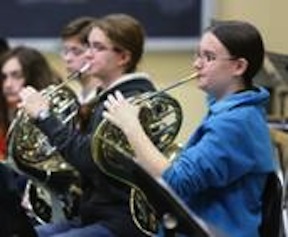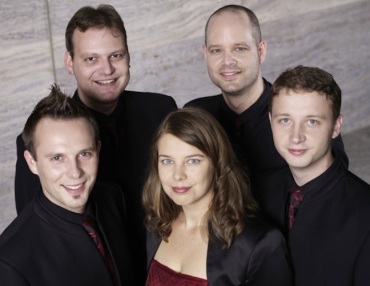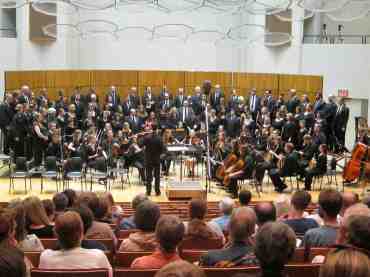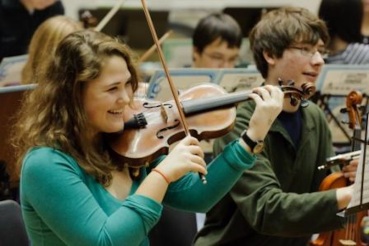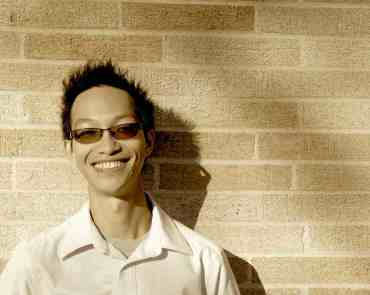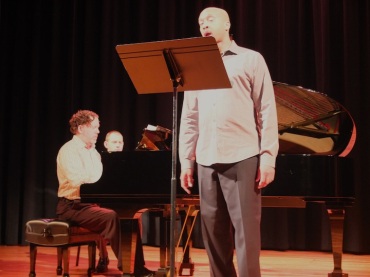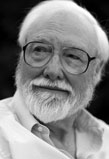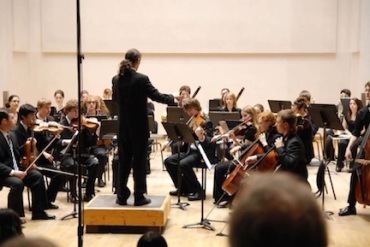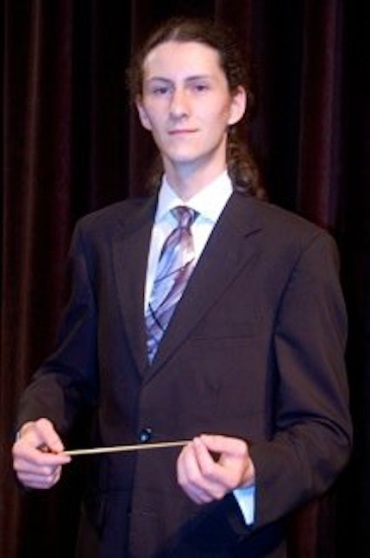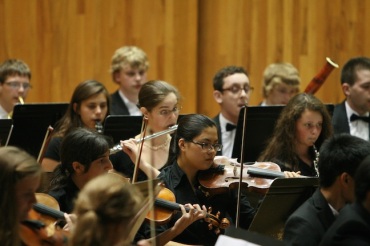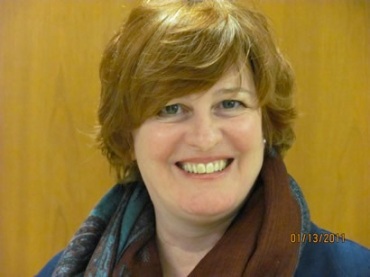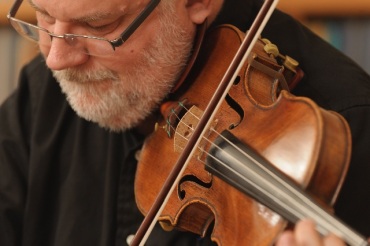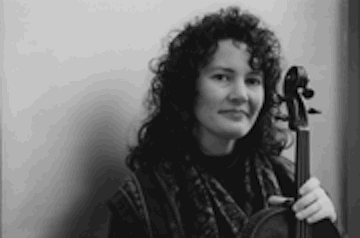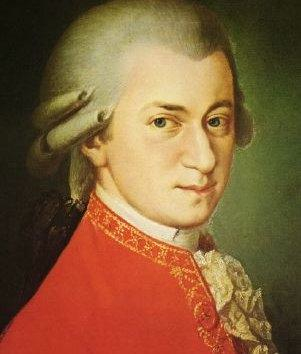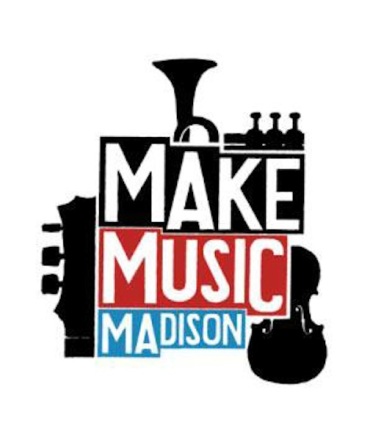The Well-Tempered Ear
Classical music: The Madison Early Music Festival sees its reputation continue to expand. It is the only Madison-area event listed in NPR’s latest guide to classical music festivals for this summer. Check out other music festivals all around the U.S. And if you can, help WYSO meet its fundraising goal at the end of its fiscal year today.
4 Comments
ALERT: It has been a good year for the Wisconsin Youth Symphony Orchestras (WYSO), both artistically and financially. But with the fiscal year deadline of June 30 looming, WYSO is nonetheless falling short of its $97,000 funding goal by $6,655, according to WYSO executive director Bridget Fraser. This exceptionally worthy organization that builds both musicians (below) and audiences through lifelong learning needs your help. If you can help, in whatever amount, WYSO to meet its goal, please visit the following link and make an on-line donation by the end of Sunday:
http://wyso.music.wisc.edu/support-wyso/
By Jacob Stockinger
The past two weeks, I have written various posts about how the summer season is now almost as busy as the regular concert season in Madison.
Here is yet another proof.
One summer festival made it into NPR’s nationwide round-up of summer classical music festivals for 2013.
It wasn’t the three-weekend run in June of the Bach Dancing and Dynamite Society. And it wasn’t the two-week Token Creek Chamber Music Festival in late August.
This year, what NRP included is the six-day 14th annual Madison Early Music Festival (MEMF), which will be held from Saturday, July 6, through Friday, July 12. It has the theme of the “German Renaissance.”
The MEMF features some outstanding groups including the Renaissance band Piffaro (below top), the Calmus Ensemble of Leipzig (below middle), the Dark Horse Consort and the viol-consort Parthenia (below bottom).
Here is a link to the festival homepage with links to specific concerts, workshops and lectures including the inaugural Handel aria competition on Monday, June 8. (At bottom s a YouTube video with countertenor Andreas Scholl singing the most frequently heard video of a Handel aria on YouTube. Can you guess which one? Do you think it will be sung in the MEMF competition?)
http://continuingstudies.wisc.edu/lsa/memf/
Of course you can also get to the MEMF site by clicking on the name in the NPR listing. Here is a link to that round-up, which might prove especially helpful if you plan on traveling this summer and want to hear some love classical music in the East (Mostly Mozart Festival), Midwest, South, Southwest and West:
Classical music: Even summer now has its classical music “train wrecks” and scheduling conflicts. Just look at this Saturday night with simultaneous performances by the Bach Dancing and Dynamite Society and the Madison Summer Choir.
4 Comments
By Jacob Stockinger
It’s bad enough when you have to choose between two or more very appealing concerts taking place at the same time during the regular fall, winter and spring season.
But the now the summer concert season has grown so rich that more and more of such scheduling conflicts – of “train wrecks,” as a good friend of The Ear and of classical music likes to call them – keep happening.
Last Friday night, I had to choose between the Madison Area Youth Chamber Orchestra and the Bach Dancing and Dynamite Society, among other events on the Summer Solstice and during the Make Music Madison festival. Both were, by all accounts, very rewarding events.
What, one wonders, will the future bring?
For the moment, however, my focus is on the present — on another such conflict that will happen this coming Saturday night, June 29. That’s when I and others will have to choose between two events very worthy events that are both attractive.
For one, there is the opening of the third and final weekend of the Bach Dancing and Dynamite Society. The concert is at 7:30 p.m. in the Overture Center‘s Playhouse (below).
The intriguing and quite original program includes Dick Kattenburg’s Quartet for flute, violin, cello and piano; Erich Wolfgang Korngold‘s unusually scored Suite for Piano, Left Hand, Two Violins and Cello; and Ludwig van Beethoven‘s famed “Archduke” Piano Trio.
The performers, who have proven reliable and inspired in past years, include cellist Jean–Michel Fonteneau (below top) and violinist Axel Strauss (below bottom), who, with BDDS co-founder and co-director pianist Jeffrey Sykes, make up the San Francisco Trio.
And for the Korngold suite, Madison Symphony Orchestra Concertmaster Naha Greenholtz (below) will make her BDDS debut — and not her last appearance, The Ear suspects.
(On Friday night at the Stoughton Opera House and on Sunday at the Hillside Theater (below) at the Frank Lloyd Wright historic compound Taliesin in Spring Green, the trio will Aaron Copland’s Violin Sonata transcribed for flute; a Mozart piano concert (No. 22 in E-flat, K. 482) in a chamber arrangement; and a very intriguing piano trio arrangement of Johannes Brahms String Sextet in G Major, Op. 36. For information about all the BDDS concerts visit: http://www.bachdancinganddynamite.org
Competing with that event, and right at the other end of State Street, is the single performance of “The Power of Music” by the Madison Summer Choir (below) under the very active and capable Madison choral conductor Ben Luedcke. It will be held at 7:30 p.m. in Mills Hall on the UW-Madison campus.
The unusual and appealing program includes the “Saint Cecilia” Mass by French composer Charles Gounod as well as music by Virgil Thomson, Johannes Brahms, Josef Rheinberger and Thomas Tomkins.
Tickets are $8 for general admission, $5 for students. For more information, visit: http://madisonsummerchoir.org
Why, The Ear asks, can’t there be more cooperation among performers and presenters to prevent that kind of conflict, which benefits no one?
Such solutions do happen.
It used to be, for example, that for quite a few years a concert-goer had to choose on a mid-July Saturday night between attending the All-Festival Concert (below top) of the Madison Early Music Festival and going to the very popular outdoors and FREE “Opera in the Park” (below bottom) put on by the Madison Opera and members of the Madison Symphony Orchestra.
But the two groups seem to have worked out a solution that should satisfy all fans of vocal music and singing.
This summer, for example, the MEMF’s final concert “Stuttgart 1616,” featuring music by Michael Praetorius and others, will take place on Friday night, July 12, at 7:30 p.m. in Mills Hall; while Opera in the Park will be on Saturday night, July 13, at 8 p.m. in Garner Park. The two events might be close and crowded, but attending both is quite do-able.
So, I ask, why couldn’t the Madison Summer Choir perform on, say, Sunday night, since the Bach Dancing and Dynamite Society has had its summer schedule pretty well set for many years. Maybe the hall was already booked; maybe it was just a mistake or an oversight.
True, one could drive to Spring Green to catch up with the BDDS on Sunday (when BDDS will perform its Friday program at 2:30 p.m. and its Sunday program at 6:30 p.m.) after attending the Madison Summer Choir concert. But that seems a bit extreme and hectic to ask of people.
Anyway, The Ear hopes – and suspects that many listeners share that hope – that such mutually exclusive choices can be eliminated or at least minimized next summer and in the future.
In the meantime I will readily admit that such conflicts between worthy concerts may be the price we have to pay for having such a vibrant and active classical music scene in Madison. But it is unfortunate nonetheless.
I hope both events draw good audiences and prove artistically successfully. I expect they will.
Yet however satisfied you feel about whatever one you go to, I suspect you will also feel a sense a loss of the one you didn’t and couldn’t attend.
And that is too bad.
What are you thoughts about this?
How do you resolve such conflicts for yourself, and think performers and presenters should?
The Ear wants to hear.
Tags: Axel Strauss, Bach Dancing and Dynamite Society, Erich Wolfgang Korngold, Jacob Stockinger, Johannes Brahms, Ludwig van Beethoven, Madison, Madison Early Music Festival, Madison Opera, Madison Summer Choir, Madison Symphony Orchestra, Opera in the Park, Orchestra, Overture Center, San Francisco Trio, Stoughton Opera House, Taliesin, University of Wisconsin–Madison
Classical music Q&A: Station manager James Steinbach talks about how Wisconsin Public Television is collaborating with educators to broadcast more music and performing arts events as part of its “Young Performers Series.”
1 Comment
By Jacob Stockinger
Wisconsin Public Television has always been a great source of information, entertainment and enlightenment for viewers who like and appreciate the performing arts. Over the years, The Ear has been a devoted fan of “Live From Lincoln Center,” “American Masters” and much more.
But now, with new equipment, the statewide PBS network is planning to bring viewers even more local arts coverage.
Despite his hectic schedule, WPT’s Director of Television and Station Manager James Steinbach, who oversees the six-station network, took time out to talk about future plans – and achievements over the past year, which the Ear has watched and liked very much — with The Ear.
Here is my Q&A with James Steinbach (below):
Is WPT planning to change how it covers classical music and other genres of music or the performing arts? (The Jewel Box concert by the Madison-based Bach Dancing and Dynamite Society in the Stoughton Opera House last summer comes to mind.) How will it change and what role does some new equipment make it possible?
Wisconsin Public Television has made a renewed commitment to covering the arts and classical music around Wisconsin, with a specific focus on our state’s talented young performers through a project called the “Young Performers Initiative.”
Our first “Venture Forward” capital campaign outfitted a new high-definition remote production studio, which has greatly expanded our ability to travel the state and capture what is important to the communities we serve. With enhanced mobility, we are able to visit concert halls, stages and schools to share the wonderful talent of our youth and their educators with our statewide audiences.
Are there certain events like the Madison Symphony Orchestra concert with the Naughton Twins, the University of Wisconsin’s Pro Arte String Quartet and the Wisconsin School Music Association State Honors Concerts set up? Are specific broadcast dates and times set, and when are they?
We launched our “Young Performers Initiative” with the “State Honors Concerts” (http://wptschedule.org/series/1579/State-Honors-Concerts/9) in February (below top) followed by the “Final Forte” (http://www.wpt.org/final_forte) (below bottom) in March and “Live at Overture: The Naughtons” (http://wptschedule.org/episodes/76939/Live-at-Overture-The-Naughtons/) in April.
Most recent was our annual broadcast of the “UW Spring Varsity Band Show.” (http://wptschedule.org/episodes/169325/UW-Varsity-Band-Spring-Concert/Any-Dream-Will-Do/) And in early June we featured “Spirited Songs: A Choral Celebration.” (http://wptschedule.org/episodes/210088/Spirited-Songs/) Also in June, we will be recording the 2013 Tommy Awards at the Overture Center for later broadcast. Check out www.wpt.org for more broadcast details.
For the coming years, we have mapped out a potential production schedule to continue this commitment to featuring young artists on a regular basis. This is an ambitious and important effort for the station and our partners — Milwaukee Public Television, Wisconsin Public Radio and the Wisconsin School Music Association.
Why does WPT want to do this?
The “Young Performers Initiative” provides a focus area through which to celebrate the vibrancy of Wisconsin communities, to raise awareness for the events they take pride in, and to inspire new generations of support and participation in these activities.
Despite economic headwinds, the arts remain an important part of Wisconsin life due to the unrelenting and collaborative efforts of arts proponents, educators and community leaders around the state. We want to shine a spotlight on these efforts, and celebrate the continued dedication and talent of Wisconsin’s young performers and those who inspire them.
The performances we share with viewers around the state are certainly inspiring. Equally inspiring is the work educators and young people do every day in their classrooms.
To support and enhance this work, we’ve partnered with Wisconsin School Music Association (a photo of its Waunakee headquarters is below) to develop and disseminate unique, effective and local classroom resources to complement existing arts curriculum.
These resources will include repurposed performance video featuring Wisconsin’s young artists, the state’s standards-based lesson plans, viewing guides and behind-the-scenes footage, including effective rehearsals, inspiring interviews and more.
We know from research that involvement in and simply exposure to the arts can offer a lifetime of inherent benefits for children, along with enriched academic and social skills.
They won’t all be musicians or dancers or actors, but they will be tomorrow’s engaged citizens, audience and supporters.
What else would you like to say about WPT’s past, present and future coverage of local classical music (and the live music) around the state or about other arts coverage? Are there specific plans for the Milwaukee, Green Bay, Appleton, Lacrosse and other areas of Wisconsin?
We have held listening sessions in almost all regions of the state to learn what’s important to each community. What are the events and concerts they are most proud of? We have plans to return to all the listed communities, and more in the coming years. We look forward to celebrating the events, people and places that bring the arts to life in Wisconsin.
What else would you like to add?
We know, with absolute certainty, that many young people across the state are practicing their hearts out with supportive parents, teachers and communities behind them. These hardworking and talented young people deserve to be seen, heard and recognized on a statewide scale. Great kids doing great things? Public television should be there!
Check out this video for more information about the Young Performers Initiative:
http://www.youtube.com/watch?v=MnswAXzOxrQ
Classical music: Radio station WORT FM will air music and interviews by local composers Jerry Hui and John Harbison starting this Thursday morning. Plus, tonight at 7 the Wisconsin Chamber Orchestra opens its 30th annual Concerts on the Square.
Leave a Comment
ALERT: Tonight, at 7 p.m. on the King Street corner of the Capitol Square downtown, is the opening the 30th annual series of Concerts on the Square (below top) by the Wisconsin Chamber Orchestra. Although most of the programs for the next six Wednesdays (rain dates are Thursdays) feature mostly pop, folk and rock music, tonight’s is an all-classical program with the student violinist David Cao (below bottom), who won this year’s WCO concerto competition for young people. He will solo in the tuneful and irresistible Mendelssohn Violin Concerto (the opening with Janine Jansen is in a YouTube video at the bottom). Also featured are works by Prokofiev (“Peter and the Wolf”), Tchaikovsky (excerpts from “Sleeping Beauty”) and Respighi. For more information about tonight’s event and all six Concerts on the Square, use this link:
http://wcoconcerts.org/performances/concerts-on-the-square/
By Jacob Stockinger
The Ear’s good friend Rich Samuels (below), who loves classical music and hosts his weekly radio show “Anything Goes” every Thursday morning from 5 a.m. to 8 a.m. on the community-sponsored radio station WORT-FM (89.9) writes:
“I’ll be broadcasting Madison composer Jerry Hui’s Internet opera “Wired for Love” on my show in two segments: Acts I and II (beginning at 7:08 am) on June 27; the final act will begin at 7:08 on July 4. I’m airing the work in two segments on account of its length. I also want it to air during the 7 a.m. hour when more people are able to listen.
“Pre-recorded interviews with Jerry – who wrote and staged the opera (below) as his Doctor of Musical Arts thesis at the UW-Madison School of Music — will be included on both dates.
“It will be interesting to see what Jerry Hui — below — comes up with for the next Madison Area Youth Chamber orchestra (MAYCO) concert on Aug. 9.
“On July 11, I’ll be airing a pre-recorded interview with the Pulitzer Prize-winning and MacArthur Fellow or “genius” grant-winning composer and Token Creek Chamber Music Festival co-director John Harbison (below).
“I will also play a recording of his “Remembering Gatsby,” a precursor of his opera based on the novel by F. Scott Fitzgerald. A concert version of “The Great Gatsby,” which was commissioned and premiered at the Metropolitan Opera in New York City, will be performed at Tanglewood that same evening.”
“I’ll be programing lots more Harbison in weeks to come. He turns 75 at the end of the year.
Classical music: The Bach Dancing and Dynamite Society triumphs and gets a standing ovation from a full house for bringing dramatic story-telling to the romantic music of Robert Schumann, Clara Schumann and Johannes Brahms.
5 Comments
By Jacob Stockinger
It was nothing short of a triumph for the Bach Dancing and Dynamite Society.
The Ear surely couldn’t be the only listener who came away Saturday night deeply moved from the Overture Center’s Playhouse — and from the fourth concert of the six that the Madison-based BDDS is offering this month — with one overpowering thought: We need more of this!
We need more concerts with first-rate songs and first-rate singing. And we need more concerts that have a narrative and tell the personal story behind the music and musicians they feature.
A lot of musical groups and individuals today offer brief introductory remarks to help prepare audiences. And that is fine. Experts say that providing that kind of listener-friendly context will help draw younger, newer and bigger audiences.
In this 22nd summer season, when the theme of card playing is highlighted, BDDS trumped that wisdom and raised the stakes by going one better, by upping the ante: Co-founder and co-director pianist Jeffrey Sykes, who got his doctorate at the UW School of Music and now teaches at the University of California-Berkley, showed his inventive theatrical side by creating an original story about the complex romances of Robert Schumann, his wife Clara Wieck Schumann and the young Johannes Brahms –- whose photographic portraits were projected on the backdrop (below).
Moreover, Sykes’ two-act mini-drama -– an experimental scissors-and-paste tapestry woven together with snippets of letters, diary entries and of course music -– proved successful on every count. It was greeted with cries of Bravo! and an enthusiastic, prolonged standing ovation.
Of course, Sykes was not alone in bringing this successful experiment off. He had the help of his co-founder and co-director flutist Stephanie Jutt.
Most importantly, for this concert he had the top-flight talents of bass-baritone Timothy Jones (below top), whose diction and tone are superb, and of the UW-Madison graduate and Lyric Opera of Chicago soprano Emily Birsan (below bottom), who possesses equally beautiful tone and excellent German as well as French.
BDDS also drew on the talents of Madison Symphony Orchestra and Madison Opera maestro John DeMain, a willing sport who did terrific double-duty as a pianist and as Clara’s difficult father Friedrich Weick. The singers also did double duty with Jones playing Robert Schumann and Birsan playing Clara Weick.
Flutist Jutt played Romances by both Robert and Clara Schumann, the first transcribed from the oboe and the second from the violin. Her performances and her readings too were expressive and fit right in with the playing and recitations from others.
The excerpts that Sykes chose from song cycles were spot on, especially from the heart-wrenching cycle by Schumann’s “A Woman’s Life and Loves.”
But nowhere was the formula of tinkering with tried-and-true classics more successful than in Robert Schumann’s song “Widmung” (Dedication), which was used to mark the consummation of the romance when a German court decides, over father Friedrich Wieck‘s libelous objections, that Roberta and Clara can indeed marry.
The song, usually sung by either a male or female voice, was shared. (For the usual interpretations, see the YouTube videos at the bottom with Jessye Norman and Hermann Prey.) And the duet was profoundly moving as Jones’ Robert and Birsan’s Clara walked free and in love off the stage and arm-in-arm to conclude the first half (below).
Similarly, when Birsan’s Clara sang “Now you have hurt me for the first time” after her beloved Robert had died, was there a dry eye in the house? Not where I sat – and I doubt where many others sat too.
Sykes wove his tapestry seamlessly. He also took a letter about a short musical theme or motif that came to the delusional Robert Schumann in the insane asylum, where his wife Clara was forbidden from visiting him until two days before he died. And then he wrapped a letter by Robert around it as well as a letter that Brahms later wrote to introduce to Clara his variations on that theme same for piano-four-hands, performed by Sykes and DeMain as the conclusion finale.
Of course one can nitpick. Given how much solo piano music, filled with bittersweet longing, that both Robert Schumann and Johannes Brahms composed, I kept wondering why the program didn’t include the short and deeply moving Romance in F-sharp Major by Schumann which Clara asked her grandson Ferdinand to play while she lay expiring on her deathbed. (It is below top, in a YouTube video) Or play the late Romance in F Major, Op. 18, No. 5, by Brahms (below bottom, in a YouTube video by Evgeny Kissin). How The Ear would have loved to hear Sykes, with his rich tone and natural lyricism, perform these miniature gems.
But you can’t have everything and what we got was plenty generous. It cohered. It moved you. And it provided an intelligent context for understanding the romance behind the great Romantic music of these Romantic composers.
All paintings need a frame, and so does a lot of music. This frame could not have been better designed and executed or more beautiful.
But that Schumann-Brahms drama-concert was not the only reason to take in the second of the three weekends of music by the BDDS.
Just the night before at the refurbished Stoughton Opera House, the group used the same singers to perform another great concert. The program was timely and relevant, given both the Afghanistan War and the anniversary of the America Civil War.
The musical offerings featured Timothy Jones in Ned Rorem’s movingly spiky and grim “War Scenes” songs drawn from Walt Whitman’s Civil War notebooks (“The real war will never get in the books’) and Emily Birsan in “Sonnets to Cassandra” by the French Renaissance poet Pierre de Ronsard by the underplayed and underrated Swiss composer Frank Martin.
The concert began with a flute quartet by Ferdinand Ries, a student of Beethoven who nicely fit the theme of a “Stacked Deck” since history has largely overlooked and forgotten him. (But, you know, Beethoven really wasn’t much of a flute guy anyway.)
The real gem came when several local string players – violinist Suzanne Beia and cellist Parry Karp of the UW-Madison’s Pro Arte Quartet and principal violist Christopher Dozoryst of the Madison Symphony Orchestra – joined pianist Sykes in playing a superb rendition, by turns turbulent and lyrical, of Gabriel Faure’s Piano Quartet No. in G Minor (below).
It was yet another reminder of how, like BDDS, Faure is a first-rate composer, with a sound and style unmistakably his own, who deserves a much higher profile and a much wider hearing.
Next weekend brings two final BDDS concerts — in Madison, Stoughton and Spring Green — with violinist Naha Greenholtz (concertmaster of the Madison Symphony) and San Francisco Trio members violinist Axel Strauss (now teaching at McGill University in Montreal) as well as cellist Jean-Michel Fonteneau in music by Copland, Mozart, Brahms, Korngold, Beethoven and Dick Kattenburg.
For more information about the times and venues, the programs, the performers and tickets, here is a link:
http://www.bachdancinganddynamite.org
If you love classical music, to miss these BDDS performance is to deprive yourself of great pleasure and great insight, of new exposure to works both well-known and neglected. Why would you want to do that?
Tags: Axel Strauss, Bach Dancing and Dynamite Society, Clara Schumann, Evgeny Kissin, Ferdinand Ries, Gabriel Fauré, Hermann Prey, Jacob Stockinger, Jessye Norman, Johannes Brahms, John DeMain, Ludwig van Beethoven, Madison Opera, Madison Symphony Orchestra, McGill University, Ned Rorem, Overture Center, Pro Arte Quartet, Robert Schumann, Schumann, Stoughton Opera House, University of California-Berkeley, UW-Madison, Walt Whitman, YouTube
Classical music: How do you cope with wrong notes you hit or hear? Pianist Stephen Hough has a healthy and helpful point of view.
8 Comments
By Jacob Stockinger
None of us likes hitting wrong notes.
And most of us detest hearing wrong notes almost as much as making them.
But does that mean that we are being too perfectionist with ourselves and others?
It could be that wrong notes may lie at the heart of the musical experience as a LIVE event.
The outstanding, award-winning British pianist and prolific blogger Stephen Hough (below), who has played several times in Madison at the Wisconsin Union Theater and with the Madison Symphony Orchestra, recently posted a blog entry that dealt with that issue.
Hough makes some interesting and convincing points that might just help us in our own playing and performances.
And he backs up what he says with some personal and historic examples of wrong notes hit by some very famous musicians, including famed piano virtuoso Vladimir Horowitz (below top). (I forget who it was but somebody remarked that arch rival pianist Arthur Rubinstein (below bottom), renowned for his rich tone, often hit wrong notes. And the response was: “But what wrong notes!“
Anyway, here is a link to the blog post:
Take a read and be sure to listen to the examples and read some of the comments left by others.
See what you think.
Then let the rest of know your reaction to Hough – and to how you cope with hitting or hearing wrong notes.
The Ear wants to hear.
Classical music: What does it feel like to hold, play and hear Mozart’s own violin and viola? America just had its first chance ever to find out. Here’s a report.
2 Comments
By Jacob Stockinger
If you want some idea of what a prodigious talent the composer Wolfgang Amadeus Mozart (1756-1791, below) was, you might recall not only his enormous amount of music in 35 years with such a high percentage of masterpieces, or his astonishing virtuosity as a keyboard player (he composed all and premiered most of his 27 piano concertos).
You might also recall that he was an outstanding violinist — his oppressively ambitious father Leopold said that his son could have become the best violinist in Europe with some more effort and work – and also a violist who loved to pay the viola in the same string quartet where fellow composer Franz Joseph Haydn played the violin.
Anyway, for more than 200 years Mozart’s instruments have been stored in a museum in Mozart’s hometown of Salzburg, Austria.
But the instruments were recently brought to the United State for the first time in history and appeared at the Boston Early Music Festival. (That is also where the University of Wisconsin-Madison duo Ensemble SDG, featuring keyboard John Chappell Stowe and baroque violinist Edith Hines, performed an all-Heinrich Bieber concert.)
Hearing about the unusual security measures taken for the trip to guarantee their security – including separate airplane flights — is fascinating.
But most fascinating of all is a first-person account of what it feels like to hold and play and listen Mozart’s own string instruments, which generally featured mellowness rather than brilliance.
You can hear about it all on NPR’s great classical music blog “Deceptive Cadence” and through writer Anastasias Tsioulcas’ experience with Mozart’s own string instruments. (Below is a photo by Kathy Wittman of Amandine Beyer holding the violin backstage in Boston during the festival.)
Here is a link. Do yourself a favor listen to it — don’t just read the transcript. I hope that you enjoy it and that it enhance even further (deeper?) your opinion of Wolfie:
http://www.npr.org/blogs/deceptivecadence/2013/06/14/190975113/playing-mozart-on-mozarts-violin
And here is a link to a live performance on Mozart’s own:
http://www.npr.org/event/music/191709140/mozarts-violin-comes-to-boston-live-in-concert
Of course, possessing a fine instrument doesn’t guarantee being a great composer. But Mozart could play his own works, including the Violin Concerto No. 3, which you can hear below with Hilary Hahn in a YouTube video that has had more than a million hits:
Classical music: The Madison Symphony Orchestra’s series of three FREE organ concerts on Farmers’ Market Saturdays starts this Saturday at 11 a.m. in Overture Hall with Ripon native Jared Stellmacher and Chicago’s Gargoyle Brass. Plus, The Ear will publish mini-reviews you send me of classical concerts held during today’s citywide Make Music Madison festival.
2 Comments
ALERT: Today, Friday, June 21, is the Summer Solstice. That means it is also the inaugural FREE Make Music Madison festival. Live music will be made citywide outdoors and indoors by individuals and groups. The Ear can’t be everywhere. So send me your mini-reviews of classical music performances, and of the festival in general, and I will publish them together in a separate posting. Just leave your remarks in the COMMENT section. If you want to know more, here is a link to the festival’s website where you will find listings for performers and times: http://www.makemusicmadison.org
By Jacob Stockinger
FREE performances of the Overture Concert Organ will be hosted by the Madison Symphony Orchestra during Dane County Farmers’ Market on three Saturdays this summer – this Saturday, June 22, plus July 20 and August 17. Concerts last 45 minutes and are held at 11 a.m. at Overture Hall in the Overture Center, 201 State Street.
No tickets or reservations are needed for these 45-minute concerts that feature Jared Stellmacher, the Gargoyle Brass, Wyatt Smith, Sam Hutchison and 14-year-old newcomer Adrian Binkley.
A complete list of Overture Concert Organ performances, with complete program of works to be performed, is at madisonsymphony.org/organperformances.
Here is a schedule of specific concerts:
This Saturday, June 22: A native of Ripon, Wis., organist Jared Stellmacher (below) returns with the Gargoyle Brass at 11 a.m. to solo in three pieces for organ by Marcel Dupré, Carlyle Sharpe and Johann Sebastian Bach.
Stellmacher will be joined by the Gargoyle Brass (below) — an ensemble from Chicago named after the many gargoyles on the campus of the University of Illinois — in special arrangements for organ and brass of a polka and fugue by Jaromir Weinberger, two movements from Gustav Mahler’s Symphony No. 2, and the “Drinking Song” from Giuseppe Verdi’s “La Traviata.”
You can hear brief audio samples of both Jared Stellmacher and the Gargoyle Brass in YouTube videos at the bottom.
Saturday, July 20: Award-winning organist Wyatt Smith (below) returns to the stage at 11 a.m. with J. S. Bach’s Toccata in F and an intriguing selection of virtuosic movements from Kurt Knecht’s Missouri Sonata and Louis Vierne’s popular work, the Symphony in D.
Saturday, Aug. 17: Audiences will receive a special treat at 11 a.m. with the debut of a young rising star from Waunakee, Wis. Fourteen-year-old organist Adrian Binkley (below top) is a student of MSO Principal Organist Samuel Hutchison (below bottom).
Adrian is already an experienced recital artist and plans to study organ performance at the Interlochen Center for the Arts in Michigan next fall. Both he and Samuel Hutchison will perform at this concert.
The Free Farmers’ Market Concerts are generously sponsored by Pleasant T. Rowland Foundation and are presented in partnership with Overture Center for the Arts and 77 Square. Support for all Overture Concert Organ programs is provided by the Diane Endres Ballweg Fund with additional support from Friends of the Overture Concert Organ.
With a gift from the Pleasant T. Rowland Foundation, the Madison Symphony Orchestra commissioned the Overture Concert Organ, which is the stunning backdrop of all MSO concerts. MSO Principal Organist, Samuel Hutchison, programs and curates it. In addition to the Free Farmers’ Market Concerts, the instrument is featured in the MSO Christmas and April 2014 concerts along with three Free Community Hymn Sings and a Christmas Carol Sing. See details for all organ performances at www.madisonsymphony.org/organperformances.
Learn more at www.madisonsymphony.org.
